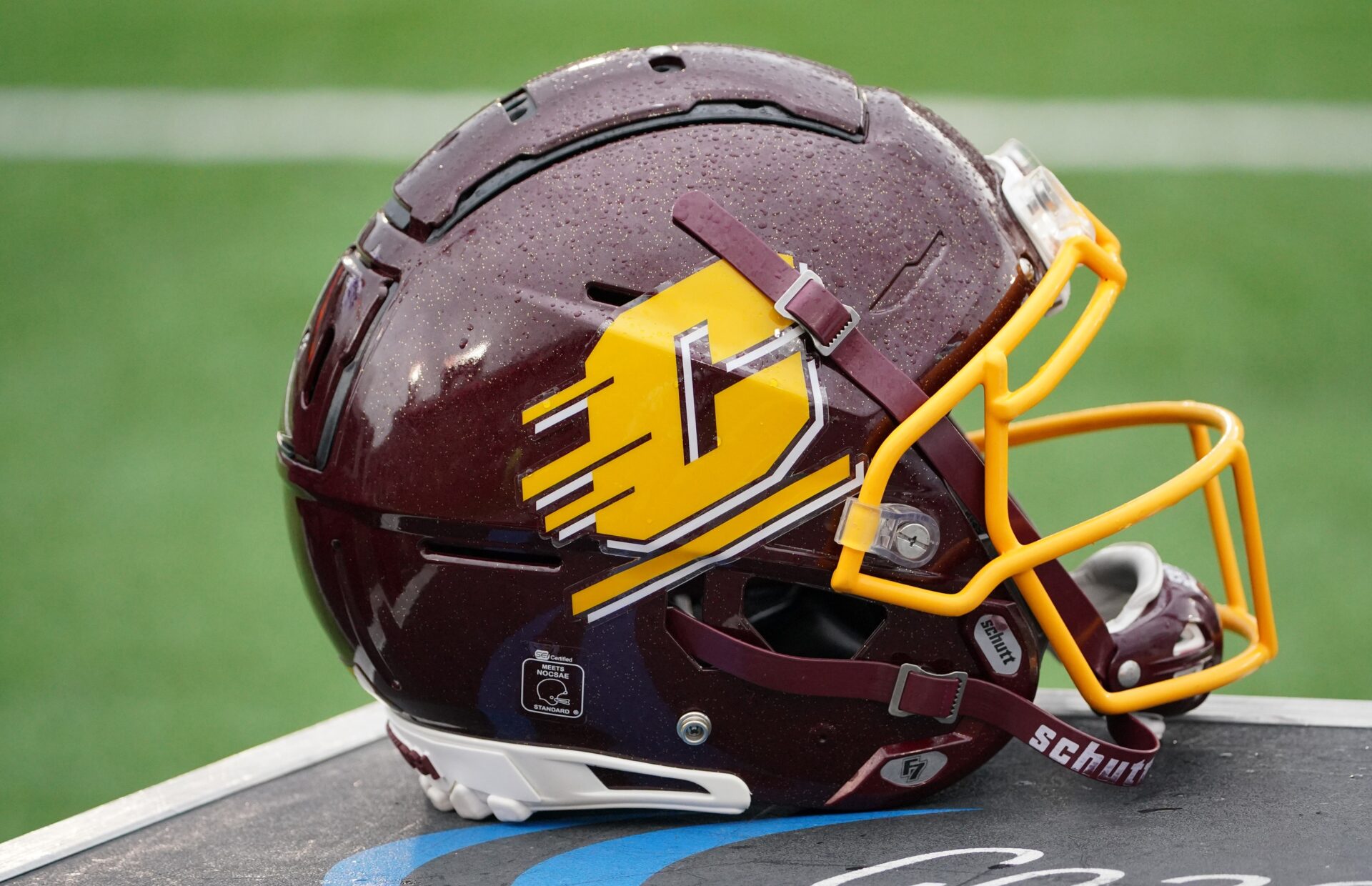Some college football programs have a costumed mascot. Some have a live-action animal mascot prowling the sidelines on a Saturday. Then, there are some programs that defy convention. There is no Central Michigan Chippewas mascot, but that doesn’t mean there’s no history. In fact, it’s quite the opposite.

What Is the Central Michigan Chippewas Mascot?
Central Michigan is a rarity in college football in that there is no Chippewas mascot. This has led to derision in some quarters, especially considering that the basketball team has a costumed mascot called Rowdie — a human/basketball-hybrid with a giant head and a welcoming style — that has been present since 2003.
Rather than a Chippewas mascot, Central Michigan has built up a strong brand for the CFB team based around its logo.
MORE: History of the Iowa State Cyclones Mascot
The current iteration was introduced in 1996, changing from a block “C” to what is known as the “Action C,” a slightly italicized letter “C” adorned with what can only be described as go-faster stripes protruding from the left side.
The style of the “Action C” gives the impression of the Central Michigan logo effortlessly and speedily moving through space like running backs Curtis Adams, Jesse Lakes, or Lew Nichols III.
Why Is Central Michigan the Chippewas?
While there may not be a Chippewas mascot, the history of the Central Michigan football program’s name and brand is as fascinating and contentious as any in college football.
Until 1941, the program and the university itself had existed under a multitude of names. However, in November of that year, Lawrence (Doc) Sweeney — the program’s line coach — decided that a change was needed to provide Central Michigan with a fitting and definitive identity.
His argument was based on the current nickname being irrelevant to the geographical location of the program and lacking in the pageantry that has always been one of the pillars of college football.
Sweeney argued that naming Central Michigan the “Chippewas” had far greater cultural ties than any of the previous names. He pointed to the Chippewa River and the name of the college yearbook as examples to why the name was a perfect fit for the program.
Yet, a further example strengthened his cultural reasoning.
The Chippewa Indian tribes once inhabited the lands around the program’s Mount Pleasant location. Sweeney commented that using the name for the university’s athletic teams would “open up unlimited opportunities for pageantry and showmanship for the band as well as athletic teams” at a time when cheerleaders and bands were becoming an integral part of the sport.
Sweeney proposed that the program embraced all aspects of the Chippewa iconography as they adopted the nickname.
MORE: History of the Akron Zips Mascot
“The Indian chief would be an outstanding marker for athletic uniforms,” he argued. “The Indian pow-wow could replace the pep meeting, and Indian ceremonies could be conducted on many occasions. School flags could be made much more attractive, and finally, all types of Indian lore have a strong appeal and could be used to great advantage.”
Sweeney’s suggestion was put to a vote early in 1942 and found overwhelming in favor. It was adopted for the next season and has remained ever since.
Naturally, however, the apparent cultural appropriation has been met with resistance, objection, and demand for change over the years.
In 1989, the program made sweeping changes to several elements relating to the Chippewa Tribe. They removed some of the logo that featured Native American imagery, eliminated Native American drumbeats from their bands, and developed educational programs alongside the local Saginaw Chippewa Tribal Council.
The latter point has been crucial to Central Michigan remaining as the Chippewas for over 80 years. There has been a developing relationship between the tribal community and the program during the time that they’ve shared a name.
The nickname is used to honor, not to belittle. The relationship is to strengthen and educate, not to denigrate. That is one of the reasons why there is no Chippewas mascot. There is no gaudy commercialization of the iconography associated with the name.
“The partnership goes back many decades, and I see the value in the education and outreach opportunities in sharing of the nickname,” Saginaw Chippewa Indian Tribe chief Timothy Davis is quoted as saying in July 2020.
Has Central Michigan Always Been the Chippewas?
There’s no Chippewas mascot, and until 1941, that wasn’t the nickname of the Central Michigan football program either.
The first nickname for the program was the “Dragons,” which held firm for just two years between 1925 and 1926. The name originated from the homemade dragon that would accompany the homecoming bonfire.
In 1927, it was decided that the program needed an official nickname. After experimenting with “Wildcats”, they were christened the “Bearcats” and remained that way until Sweeney deemed that the “practically extinct” nature of the animal and lack of geographical relevance deemed it unfit to represent the university.
At the time that they became the Chippewas, the university was actually Central Michigan College of Education before becoming Central Michigan College in 1955. The institution finally became Central Michigan University in 1959.

